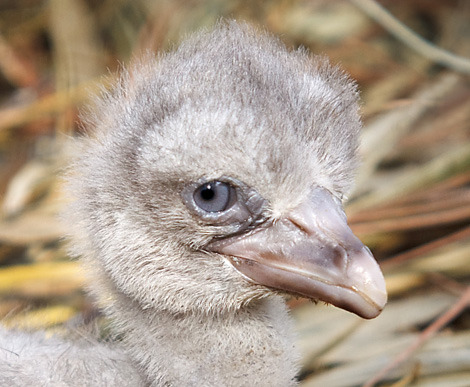The Shoebill
Let’s peek for a
moment into the life of an extraordinary bird. We will fix our eyes on a
papyrus marsh in eastern Africa, and specifically on a female Shoebill who
lives there alone (these birds are solitary creatures). She is about 4 ½ ft
tall, weighs around 12 lbs, and is slate grey all over. There are feathers
sticking out of the back of her head that lend to the image of an unruly
cowlick. Her legs rather resemble a heron’s legs, and in some ways she looks
like a stork, or a pelican. And then, of course, there is that impossible bill,
a massive thing, being 9 inches long and
4 inches broad (can you see why they call them Shoebills?), with a vicious hook
on the end. This bird is an interesting sight, don’t you think?
Since
Shoebills are nocturnal, her days are spent sleeping. Come evening, however,
our Shoebill is standing motionless, tucked away in the reeds, waiting for an
African Lungfish (her favorite food) to swim by. She is not exactly graceful as
she attacks and grapples it, but then again, that’s not the point. The point is
to swallow the fish, which is something her clog of a bill can certainly
accomplish. A few other things on the menu for our lady are baby crocodiles,
rats, waterfowl, other fish, frogs and other amphibians, small turtles, and
water snakes.
 There is no specific season when Mrs. Shoebill will
lay her eggs, but she will probably wait until the onset of the dry season,
when the nest is less likely to be flooded. Anyway, about once a year, 1 to 3
eggs will be laid on a flat nest of sticks in the swamp grass, and after about
one month the babies will hatch. Amazingly, they will not be able to stand up
until they are 2 ½ months old! I suppose those spindly legs take awhile to
develop. They will not be able to hunt for themselves until they are 3 ½ months
old.
There is no specific season when Mrs. Shoebill will
lay her eggs, but she will probably wait until the onset of the dry season,
when the nest is less likely to be flooded. Anyway, about once a year, 1 to 3
eggs will be laid on a flat nest of sticks in the swamp grass, and after about
one month the babies will hatch. Amazingly, they will not be able to stand up
until they are 2 ½ months old! I suppose those spindly legs take awhile to
develop. They will not be able to hunt for themselves until they are 3 ½ months
old.
It is thought that there are 5,000 to 8,000 Shoebills in
the world today, living in swamps and wetlands from Sudan and western Ethiopia
all the way down to Zambia. The main threat to this species is destruction of
habitat, illegal hunting and trapping, and the drying up of the marshes where
they live.
Oh, and one more thing: Did you know that
mother Shoebills will sometimes fill their bill with water and pour it over
their overheated nestlings?


No comments:
Post a Comment